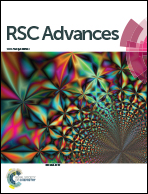The characterization of Co-nanoparticles supported on graphene
Abstract
The results of density functional theory calculations and measurements using X-ray photoelectron spectroscopy of Co-nanoparticles dispersed on graphene/Cu are presented. It is found that for low cobalt thickness (0.02–0.06 nm) the Co forms islands distributed non-homogeneously which are strongly oxidized under exposure to air to form cobalt oxides. At greater thicknesses up to 2 nm the upper Co-layers are similarly oxidized whereas the lower layers contacting the graphene remain metallic. The measurements indicate a Co2+ oxidation state with no evidence of a 3+ state appearing at any Co thickness, consistent with CoO and Co[OH]2. The results show that thicker Co (2 nm) coverage induces the formation of a protective oxide layer while providing the magnetic properties of Co nanoparticles.


 Please wait while we load your content...
Please wait while we load your content...